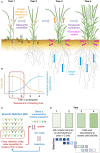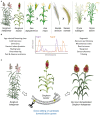Perennials as Future Grain Crops: Opportunities and Challenges
- PMID: 35968139
- PMCID: PMC9372509
- DOI: 10.3389/fpls.2022.898769
Perennials as Future Grain Crops: Opportunities and Challenges
Abstract
Perennial grain crops could make a valuable addition to sustainable agriculture, potentially even as an alternative to their annual counterparts. The ability of perennials to grow year after year significantly reduces the number of agricultural inputs required, in terms of both planting and weed control, while reduced tillage improves soil health and on-farm biodiversity. Presently, perennial grain crops are not grown at large scale, mainly due to their early stages of domestication and current low yields. Narrowing the yield gap between perennial and annual grain crops will depend on characterizing differences in their life cycles, resource allocation, and reproductive strategies and understanding the trade-offs between annualism, perennialism, and yield. The genetic and biochemical pathways controlling plant growth, physiology, and senescence should be analyzed in perennial crop plants. This information could then be used to facilitate tailored genetic improvement of selected perennial grain crops to improve agronomic traits and enhance yield, while maintaining the benefits associated with perennialism.
Keywords: breeding; domestication; genome editing; grain crops; perennial agriculture; perennial grains; perennialism; species-wide hybridization.
Copyright © 2022 Chapman, Thomsen, Tulloch, Correia, Luo, Najafi, DeHaan, Crews, Olsson, Lundquist, Westerbergh, Pedas, Knudsen and Palmgren.
Conflict of interest statement
The authors declare that the research was conducted in the absence of any commercial or financial relationships that could be construed as a potential conflict of interest.
Figures



References
-
- Albach D. C., Martínez-Ortega M. M., Chase M. W. (2004). Veronica: parallel morphological evolution and phylogeography in the Mediterranean. Plant Syst. Evol. 246, 177–194. 10.1007/s00606-004-0148-9 - DOI
-
- Altendorf K. R., DeHaan L. R., Anderson J. (2022). Genetic architecture of yield-component traits in the new perennial crop, intermediate wheatgrass. Crop Sci. 62, 880–892. 10.1002/csc2.20716 - DOI
-
- Altendorf K. R., DeHaan L. R., Heineck G. C., Zhang X., Anderson J. A. (2021a). Floret site utilization and reproductive tiller number are primary components of grain yield in intermediate wheatgrass spaced plants. Crop Sci. 61, 1073–1088. 10.1002/csc2.20385 - DOI
Publication types
LinkOut - more resources
Full Text Sources
Miscellaneous

